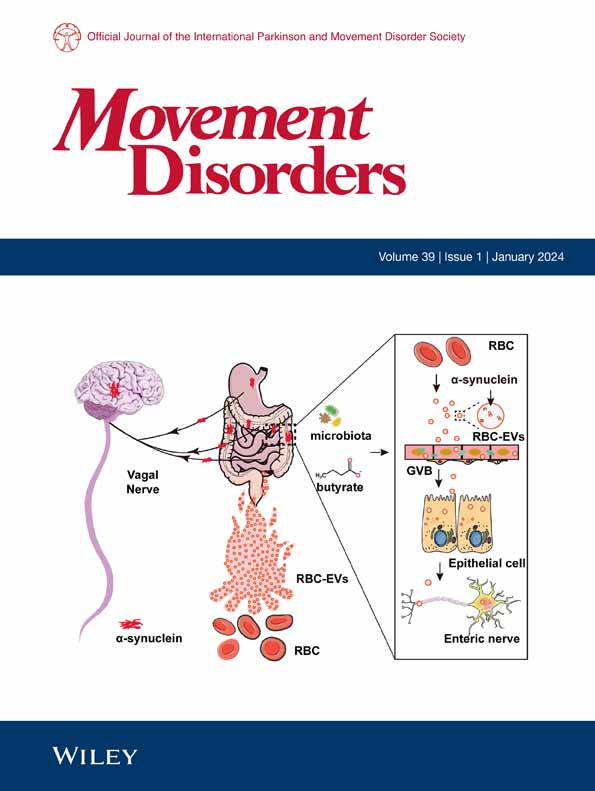基于前瞻性连接组学的帕金森病深部脑刺激方案设计
IF 7.4
1区 医学
Q1 CLINICAL NEUROLOGY
引用次数: 0
摘要
背景脑深部刺激(DBS)的疗效有赖于准确的导联放置以及刺激参数的优化。本研究调查了前瞻性自动连接组学 DBS 编程(自动连接组学编程 [ACP])的安全性和可行性,重点关注特定白质通路的招募。方法在 DBS 植入后,为每位研究参与者开发了患者特定空间的详细连接组学 DBS 模型。驱动力模型用于量化 2400 种不同 DBS 设置的通路招募。优化算法使治疗通路的招募最大化,同时使副作用通路的招募最小化。13 名受试者参加了两个阶段的研究,比较了从 ACP 导出的 DBS 设置与标准临床 DBS 设置。四名患者接受了 ACP 初始编程(3 名 GPi,1 名 STN)。所有患者均能耐受 ACP,无持续副作用。在重新编程队列中,3 名患者更喜欢他们的 ACP 程序,1 名患者认为该程序与他们的临床程序相当。初始 ACP 队列(3 名 GPi,1 名 STN)的统一帕金森病评分量表第三部分评分平均提高了 43.5%(40.4-52.6 ± 5.6%)。它提供了合理的运动改善,可通过后续临床调整进一步优化。需要进行更多的研究来完善优化算法,并在更大的群体中量化 ACP 的临床益处。© 2024 国际帕金森和运动障碍协会。本文章由计算机程序翻译,如有差异,请以英文原文为准。
Prospective Connectomic‐Based Deep Brain Stimulation Programming for Parkinson's Disease
BackgroundEfficacy of deep brain stimulation (DBS) relies on accurate lead placement as well as optimization of the stimulation parameters. Although clinical software tools are now available, programming still largely relies on a monopolar review, a tedious process for both patients and programmers.ObjectiveThis study investigates the safety and feasibility of prospective automated connectomic DBS programming (automated connectomic programming [ACP]), focusing on the recruitment of specific white matter pathways.MethodsAfter DBS implantation, a detailed connectomic DBS model in patient‐specific space was developed for each study participant. A driving‐force model was used to quantify pathway recruitment across 2400 different DBS settings. Optimization algorithms maximized recruitment of therapeutic pathways while minimizing recruitment of side‐effect pathways. Thirteen subjects were enrolled in two study phases that compared DBS settings derived from ACP to standard clinical DBS settings.ResultsNine patients underwent reprogramming with ACP (5 globus pallidus interna [GPi], 4 subthalamic nucleus [STN]). Four patients underwent initial programming with ACP (3 GPi, 1 STN). All patients tolerated ACP without persistent side effects. In the reprogramming cohort, 3 patients preferred their ACP program, and 1 patient felt it was comparable to their clinical program. Unified Parkinson's Disease Rating Scale, Part III, scores for the initial ACP cohort (3 GPi, 1 STN) improved by an average of 43.5% (40.4–52.6 ± 5.6%).ConclusionsACP appeared clinically safe and feasible. It provided reasonable motor improvement, which can be further optimized with subsequent clinical adjustment. Additional investigation is required to refine the optimization algorithm and to quantify the clinical benefit of ACP in a larger cohort. © 2024 International Parkinson and Movement Disorder Society.
求助全文
通过发布文献求助,成功后即可免费获取论文全文。
去求助
来源期刊

Movement Disorders
医学-临床神经学
CiteScore
13.30
自引率
8.10%
发文量
371
审稿时长
12 months
期刊介绍:
Movement Disorders publishes a variety of content types including Reviews, Viewpoints, Full Length Articles, Historical Reports, Brief Reports, and Letters. The journal considers original manuscripts on topics related to the diagnosis, therapeutics, pharmacology, biochemistry, physiology, etiology, genetics, and epidemiology of movement disorders. Appropriate topics include Parkinsonism, Chorea, Tremors, Dystonia, Myoclonus, Tics, Tardive Dyskinesia, Spasticity, and Ataxia.
 求助内容:
求助内容: 应助结果提醒方式:
应助结果提醒方式:


